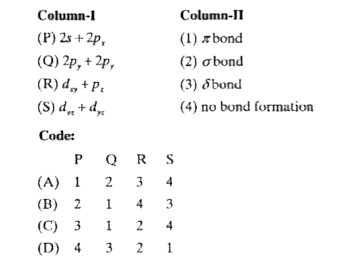When 2s orbital overlaps with or orbital (assuming Z -axis as the internuclear axis) threr is a partical overlap and they do not form any Explain why ? .
Video Solution
Text Solution
2s orbital function has same sign throughout but or orbital wave function has + ve sing in one lobe and -ve sign in the other lobe The small (+)(+) overlap cancels the (+)(-) overlap which being equal in area but opposite in sign .
|
Topper's Solved these Questions
- CHEMICAL BONDING AND MOLECULAR STRUCTUREBOOK - CENGAGE CHEMISTRYCHAPTER - CHEMICAL BONDING AND MOLECULAR STRUCTUREEXERCISE - Ex 2 .2 Subjective (Intermolecular Forces And H-Bonding)
7 Videos
- CHEMICAL BONDING AND MOLECULAR STRUCTUREBOOK - CENGAGE CHEMISTRYCHAPTER - CHEMICAL BONDING AND MOLECULAR STRUCTUREEXERCISE - Ex 2 .2 Subjective (Molecular Orbital Theory)
4 Videos
- CHEMICAL BONDING AND MOLECULAR STRUCTUREBOOK - CENGAGE CHEMISTRYCHAPTER - CHEMICAL BONDING AND MOLECULAR STRUCTUREEXERCISE - Archives Subjective
15 Videos
- ATOMIC STRUCTUREBOOK - CENGAGE CHEMISTRYCHAPTER - ATOMIC STRUCTUREEXERCISE - Concept Applicationexercise(4.3)
19 Videos
- CHEMICAL EQUILIBRIUMBOOK - CENGAGE CHEMISTRYCHAPTER - CHEMICAL EQUILIBRIUMEXERCISE - Archives (Subjective)
11 Videos
Similar Questions
Knowledge Check
Which of the following overlaps is incorrect? (Assuming z-axis to be the internuclear axis)
A2py+2py right arrow π2pyB2pz+2pz rightarrow σ2pzC2px+2px→π2pxD1s+2py→π(1s−2py)Type of orbital overlap in H2O molecule is
Asp3−sp3Bsp3−2pCsp2−sDsp3−sWhich of the following overlaps of atomic orbitals does not form π-bond if z-axis is the internuclear axis?
Adzx−pxBpy−pyCdyz−pyDdz2−dz2
If Z−aξs is the molecular axis, then π−molecular orbitals are formation by the formed by the overlap of
View SolutionIf x-axis is the molecular axis, the π-molecular orbitals are formed by the overlap of
View SolutionIf z-axis be the internuclear axis, which of the following combination of orbitals would not form π-bond?
View SolutionIf z-axis is the molecular axis, then π−molecular orbitals are formation by the formed by the overlap of
View SolutionSideways overlap of p−p orbitals forms
View Solution

